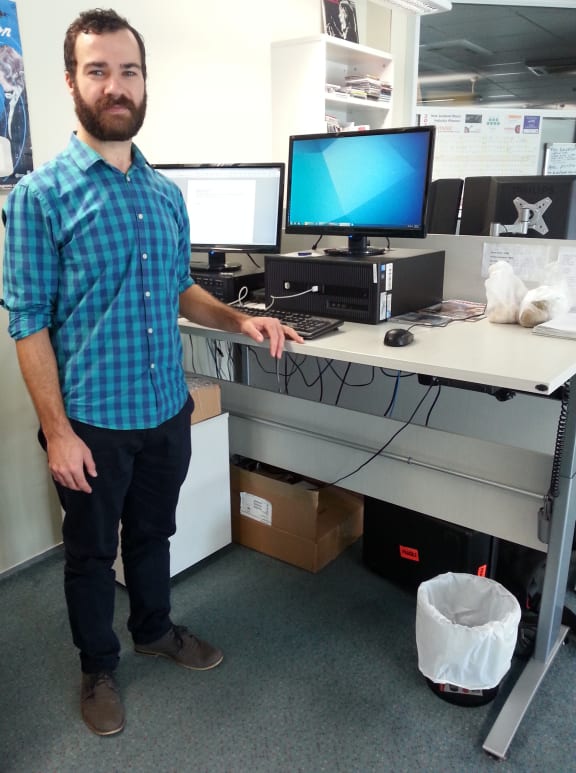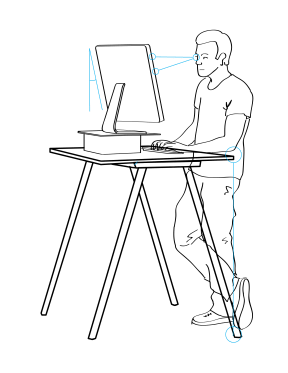By Ruth Beran
There’s a lot of hype at the moment about standing up desks, with proponents touting the benefits of standing at work rather than sitting for long periods of time.
To analyse the hype, Unitec Masters of osteopathy student Dan Archer set about trying to measure the effects of standing desks on six participants’ health, over 19 weeks. In particular, he was looking at metabolic health.
I believe there is data to show that we can reduce the risk of metabolic syndrome particularly in sedentary people, people who sit down at the office all day,” says Dan.

Dan Archer at a standing desk Photo: RNZ / Ruth Beran
Metabolic syndrome is a cluster of conditions that occur together, increasing the risk of heart disease, stroke and diabetes. These cluster of conditions are increased blood pressure, a high blood sugar level, excess body fat around the waist and abnormal cholesterol levels. To measure metabolic biomarkers, Dan was tracking blood pressure, waist circumference, height, fasting glucose, triglyceride (or fat) levels, and cholesterol in the blood.
Participants were people who primarily sit in the workplace, and were of different genders and ethnicities. People used the desks for 19 weeks, with the first three weeks being an introductory phase where participants could stand for an hour or so at a time.
Ultimately the study did not show huge changes in metabolic markers, although there was a decrease in waist circumference in some participants. Dan believes this may be because the study wasn’t long enough. “Over the 17 weeks we saw changes in some people but it might be that over a year we’d see even better changes,” says Dan. Also the factors being measured were quite transient, dependent on factors that are hard to control, like diet and lifestyle.
Anecdotally though the standing desks were a success, with all participants showing a marked decrease in their daily sitting time and marked increase in daily standing time. The smallest increase in standing was 111 minutes, and the smallest change in daily sitting was a decrease of close to two hours a day. “I had people reporting that they felt more comfortable during the day, less fatigued and more energetic. Some people mentioned slightly higher concentration levels,” says Dan.

A standing desk Photo: Angus McIntyre and Mattthew CC BY-SA 3.0
There were also some slight negative effects associated with switching to the standing desk, with some reports of mild discomfort in the lower back. “We tried to ease those with certain stretches and exercises, but overall there was a very positive response to it," says Dan.
All but one of the participants chose to continue to stand after the study.
The changes in daily sitting and standing times were evident across the entire period. “So people didn’t revert back to sitting down once they got used to it, or the novelty of the standing desk wore off,” says Dan. This makes him think that standing desks are a viable solution for intervention into occupational sedentary behaviour, even though the six participants in the study were biased because they were already interested in standing desks before the study started.
Dan believes that a larger study could examine how viable standing desks are, and what kind of changes to sitting and standing happen over a longer period of time.

